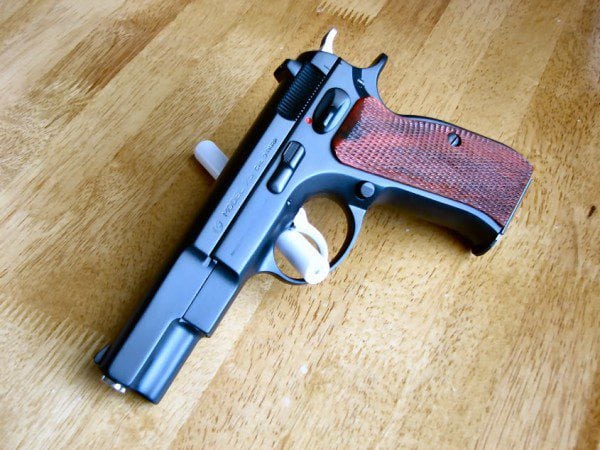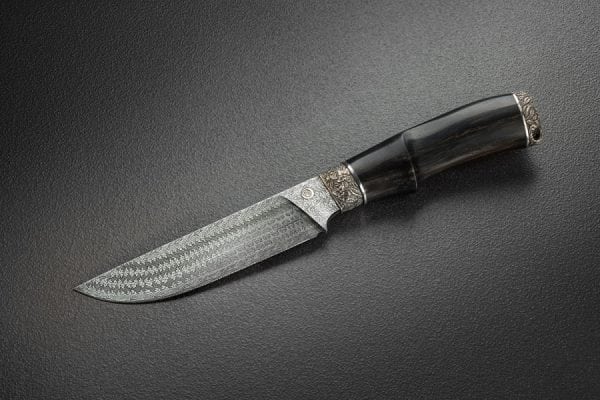Steel bluing can not only increase the external attractiveness of a weapon (PM pistol, hunting rifle, knife, etc.), but also entails practical consequences, since the barrel loses its luster and becomes less noticeable for the target. Burnishing also protects the metal from corrosive processes.
- Acid oxidation
- Grinding
- Salting off
- Degreasing
- Applying varnish
- Digestion
- Kratsovanie
- Oiling
- Buturlin Oxidation
- Other burnishing methods
- Damask steel bluing

There are a great many ways of burnishing. It is difficult to list them all in the framework of this article. Therefore, we dwell only on the most popular and relatively affordable.
Acid oxidation
The most famous burnishing method is acid oxidation. In the process of metal processing, a special solution is used - “rusty varnish”. The meaning of processing this metal substance is to accelerate the corrosion process. In its composition, “rusty varnish” is a saline solution of iron, sometimes including other metal components.
To create a "rusty varnish" you will need:
- hydrochloric acid - 50 milliliters;
- nitric acid - 54 milliliters;
- cast iron or carbon steel chips - 30 grams;
- metal scale - 20-30 grams;
- distilled water - 1 liter.
It is permissible to prepare the solution only on the street, since its components are toxic. It is necessary that the air flow comes from a person, since gas is released during the reaction.
Instructions for the manufacture of the solution:
- Pour 50 milliliters of hydrochloric acid into a glass 1.5-liter flask.
- Add chips, scale and nitric acid to the container in equal parts.
- After a while, the solution will turn green and seething will begin. This means that gas evolution has begun. It looks brownish in color.
- We are waiting for the reaction to subside and add another portion of chips, scale and nitric acid in the same proportions.
- When the next reaction stops, add the remains of the above substances.
- At the exit, we will have a red color composition similar in texture to sour cream. Let the mixture brew for 24 hours. The container with the composition must be hermetically sealed.
- After a day, go to the next stage. Pour 1 liter of distilled water into the dishes. On this, the composition can be considered ready for use.
- Shake the mixture and pour it into a container with a wide neck, through which it will be convenient to pick up the solution for work.
to contents ↑Note! Insoluble components may remain at the bottom of the container. This means that the reaction was insufficient.
Grinding
Before proceeding with oxidation, the surface must be sanded. Grinding is carried out in several steps. First of all, we walk along the surface with sandpaper: first coarse, then fine-grained. Finish grinding with a thin abrasive.
Salting off
This procedure is usually carried out in relation to elite weapons. Exfoliation (another name - matting) is carried out using round brushes and pastes, which include abrasives, technical fat and stearin. The erasing qualities of sandpaper lubricated with fat are reduced. In this case, the oxide film is removed with the help of organics contained in the fat.
The result should be a flat and smooth surface, making it much easier to process metal with polishing pastes. Salting should be done right before applying the paste.
to contents ↑Degreasing
The objective of this stage of preparation is to remove grease stains from the metal, including mineral oils. The fact is that the formation of an oxide film is possible only on a clean surface.
You will need to prepare a degreasing agent consisting of the following components (per 1 liter of water):
- caustic soda - 10-15 grams;
- trisodium phosphate - 50-70 grams;
- soda ash - 30-40 grams;
- water glass - 3-5 grams.
If the trunks are soldered with tin solder, you will need another solution:
- soda ash - 100-150 grams;
- liquid glass - 20-30 grams.
In both cases, the solution should be heated to approximately 100 degrees Celsius. The period of dipping products into the solution is from 20 to 30 minutes. Wash non-fat metal in water. Processing with "rusty varnish" should begin immediately after washing the weapons.
to contents ↑Applying varnish
Apply a “rusty varnish” with a brush (not a thick layer). We pay special attention to the end of the trunk. Excess varnish, drops, smudges are carefully removed with a brush. Touching the weapon at the time of varnishing should be avoided, since it will not be possible to obtain the desired result.
At the end of varnishing we place the weapon in a warm place. The temperature at the barrel storage location should be between 40-60 degrees above zero. In the course of how the metal will dry, it will gradually acquire a light red color.
Dry the surface with another layer of varnish. Dry the material again. Ultimately, the metal will turn dark orange.
to contents ↑Digestion
First of all, we prepare a solution for boiling out in a boiling bath. As a bath, you can use a 100 mm pipe segment with a welded bottom. Also, the heating element from the electric kettle must be connected to the pipe.
Pour rain water into the bath. It is rainwater that is needed, and not taken from the water supply, since the latter has additives that will not allow for high-quality boiling out.
To oxidize the organic matter in the water, we add nitric acid. Recommended proportion: 1-2 milliliters per 1 liter of water. Next, bring the water to a boil and wait another 3-5 minutes so that the liquid in the bathtub is ready for boiling out.
The metal, which due to the oxides has received a dark orange color, is kept in a boiling solution for 15 minutes. Gradually, the trunk begins to acquire a velvety black color. If the boil-out did not give a result and the metal is still red, this is not scary, since the blackening does not always occur for the first time. Perhaps the reason is insufficient metal degreasing or poor flushing of the surface.
to contents ↑Kratsovanie
To perform the painting, a round brush is needed, equipped with an electric drive. You can make a brush at home. To do this, you need to purchase a small wire mesh in which the diameter of the holes will be 0.1-0.15 mm. Cut out a few circles or squares in the grid, and make a hole in the center. We collect the entire package on the mandrel with the washer and nut. As an electric drive, you can use a drill, grinder, motor, etc.
Advice! When working with a brush for painting, care must be taken when wearing eye protection.
We clean the metal surface from loose iron deposits. The task is to obtain a shiny black film over the entire surface of the barrel. If the metal in some areas did not turn black, but retained a red color, burnishing for the first time failed. However, do not be upset, as this is only the first burnishing operation out of eight. Thus, to achieve the result, four boiling outs and four brimming are necessary.
to contents ↑Oiling
At the end of the fourth stage of capping, the metal will acquire a graphite color.To remove residual moisture from the oxide film (and its thickness is in the range of 0.7-1.5 microns), oiling is necessary.
Oil impregnation consists in dipping the oxidized metal in a bath with neutral heated oil. Allowed to use any engine oil, heated to a temperature of 105-110 degrees Celsius. The oiling procedure is carried out for 5 minutes.
to contents ↑Note! Cold grease should not be used because it is too viscous and therefore cannot penetrate the pores of the oxide film.
Buturlin Oxidation
To prepare the solution according to the Buturlin method, you will need to prepare a saturated solution of copper sulfate. For every 250 grams of vitriol, add 5-6 drops of sulfuric acid. We put metal in the dishes with the solution and hold it there until it begins to resemble red copper in color. After that, remove the weapon from the solution and wash it in clean water. At the end of rinsing, drain the liquid, and thoroughly rinse the container.
The next step is dissolving in hot water hyposulfite - sodium sulfite. Approximate proportion: 200 grams of substance per 250 grams of water. We filter the solution using a funnel, into which we insert filter paper or absorbent cotton. Next, add hydrochloric or hydrochloric acid to the solution (2% of the solution volume). The result of mixing should be the formation of a liquid of a dark yellow color.
Heat the solution to a boil and put metal in it. The barrel is in boiling water for 5-10 seconds. After that we take out the weapon and douse it with cold water.
Check the trunk for staining and place it in the bath for no more than half a minute. Then we take out the metal, wash it in clean cold water and again inspect the surface for quality of painting. When the trunk acquires the desired color, that is, it will darken sufficiently, it must be very carefully, without touching it with hands, washed in cold running water.
Note! The color intensity depends on the exposure time of the metal in the solution. It is not recommended to keep the barrel in the metal for too long, since there is a risk of convergence of the coating. In this case, you will need to repeat the procedure again.
Hyposulfite solution can be poured from the bath into a glass dish. This composition may still be useful for re-oxidation if hydrochloric acid is added to it. Wash the bath thoroughly from the remains of the solution.
We make in a clean container a solution of potassium alum. To do this, you need 120 grams of alum powder in 1.25 liters of water. Place the weapon in the solution for 12 hours. When this period expires, we take out the metal and wash it in cold water. Let the barrel dry and slightly heat it, and then wipe the surface with a soft canvas rag soaked in machine oil. Then leave the metal to dry in suspension for a week. After drying the trunk, its coating will acquire a blue-black color.
to contents ↑
Other burnishing methods
Below are a few more ways to burn weapons:
- We heat the trunk to high heat and intensively rub it with blood. As soon as the metal cools, continue heating. As a result, the metal will acquire a bluish tint.
- Rub the polished barrel with olive oil. Next, sprinkle the metal with sieved ash from a hardwood. We lay the trunk in a charcoal mining. As soon as the metal starts to whiten, we take it out and let it cool. Next, wipe the material twice: first dry, the second time with olive oil. The color of the metal will eventually turn gray.
- The following method will give the trunk a brown color. To do this, you will need a solution of the following components: copper sulfate - 120 grams, nitric acid - 240 grams, 90% alcohol - 250 grams, water - 1 liter. Moreover, water and alcohol must be added after the dissolution of vitriol. The prepared solution is applied to the metal, and when it dries, the first time we wipe the barrel with a thin wire brush, and the second - with a hard bristle brush.We repeat the procedure 2-3 times within 3 days and after this period we get a brown material. The last thing to do is rinse the barrel in boiling water, and then wipe it with cloth and grease it with olive oil.
- A beautiful surface can be obtained using such a composition: zinc chloride - 20 grams, vitriol - 20 grams, water - 1 liter. Sometimes the solution comes out opaque, then a few drops of hydrochloric acid need to be added to the liquid. Next, grease the surface with plenty of solution and repeat this operation 2-3 more times after the metal dries. After lubrication, wipe the surface with a soft bristle brush. Repeat the lubrication procedure for 4 days. To speed up the process, you can slightly warm the barrel.
- A pronounced dark tone can be obtained using the following components of the solution: crystalline ferric chloride - 500 grams, neutral antimony trichloride - 500 grams, gallic acid - 250 grams, water - 1 liter. Using the resulting composition, we process the surface several times, each time allowing it to dry previously. After a clear darkening of the metal, we wash the product in water, dry it and rub it with linseed oil.
- Processing by "Clover". In this case, we are talking about a means of factory production - "Clover". Before applying it, we clean the metal from grease and dirt. Then we process the “Clover” surface, which will soon acquire a yellow-white color. We wash off the substance with water and dry the surface.
Damask steel bluing
Damascus steel is not an independent type of metal. This is just a mixture of steel particles and wrought iron. In the process of etching using acidic weed, a special pattern is formed on the metal, similar in appearance to an ornament, including dark and light dashes. Moreover, if the process is carried out correctly, the light and dark lines strictly alternate with each other.
There are several ways to burn Damascus steel:
- For the preparation of the solution we use the following components: copper sulfate - 8 grams, nitric acid - 30 grams, hydrochloric acid - 2 grams, alcohol - 30 grams, water - 1 liter. First, we dissolve copper sulfate in water, and after that we add other components. Before using, the composition must be allowed to infuse for several days. At the output we get brown burnished steel.
- To get the black color of Damascus steel, you must first polish it. We process the polished surface with wood oil using cloth, and then sprinkle the metal with ash from hardwood. Next, put the barrel on hot charcoal and let the metal blacken. After the barrel removed from the fire has cooled, we wipe it with a cloth soaked in water and acidified with sulfuric acid. We wash the product in clean water, dry it and rub it with oil. As a result, we get the trunk, where all the points corresponding to the grains of steel become light. In this case, the areas where the iron is found become black.
- The blued weapon from damask steel looks very stylish if it is etched “into relief”. With such etching, steel veins stand out in relief against the background of the areas where the iron nuclei are located. In other words, etching affects only iron. To achieve this effect, we make a solution consisting of 30 grams of hydrochloric acid and 1 liter of water. Put the weapon in the solution for 4 hours. Then we take out the metal and wash it in water, wiping with tripoli. We give the trunk to dry well, and then treat it with oil and heat it over hot charcoal.
The burnishing process requires strict adherence to technological standards, it can not be called simple. Therefore, in the absence of skills, the decision to give the barrel for processing to a specialist who will carry out the work quickly and efficiently is understandable.










